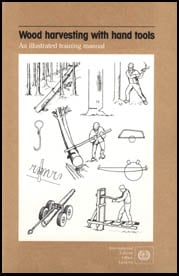
Training in Wood Harvesting[edit | edit source]
Wood harvesting, whether done with hand tools or with machines, can be a heavy and dangerous job. If it is done by unskilled persons with poor tools and inadequate working techniques, it generally results in excessive effort, numerous accidents, low productivity and also in wood waste. For this reason, training is indispensable not only for professional forest workers but also for occasional wood cutters such as rural people harvesting fuelwood or construction poles.
Obviously, such training must be adapted to the special conditions of wood harvesting. It must be done on the job, as much as possible in a practical way and on a short-term basis with follow-up visits. It should always be based on locally-available tools and equipment. The benefits of training may be lost if tools are brought just for the sake of training which cannot be bought locally or which are too expensive for village people. Under such conditions, it is important for the trainer to ensure that tools and tool handles made by rural artisans or sold by local hardware shops meet the requirements as much as possible.
Traditionally, skills are passed on from one generation to the next. Where the axe is the only wood harvesting tool, this transfer of skills normally produces quite experienced axe workers. However, the use of saws, saw maintenance tools and helping tools requires additional knowledge and skill for which training is needed.
Training of professional forest workers may last several weeks in order to reach acceptable levels of productivity with new tools and working methods. For the occasional wood cutter, the minimum would be a one-to-two day demonstration, but a one-week period including demonstrations and on-the-job practice would be preferable. This type of training should concentrate on safe working habits, reduction of physical effort and optimal wood utilisation more than on high productivity.
The trainee is provided with information, demonstrations and practice regarding tools and tool maintenance, safety rules, directional tree felling, debranching, cross-cutting, splitting, stacking and transport as required for his job. For the maintenance of tools, especially saws and wooden handles, it may be necessary to train specially selected persons who take care of this aspect for a group of workers.
Training will be readily accepted if it brings obvious benefits to the trainee. Follow-up visits are needed to further improve and correct the work.
The instructor plays a crucial role in training. He will only be accepted if he is perfectly skilled himself and if he is able to communicate in the language spoken locally. Ideally, instructors should themselves have extensive experience in wood harvesting and should undergo special training as instructors for several months.
Training of instructors for wood harvesting is included in ILO technical co-operation activities. Further information on this subject may be requested from:
Forestry and Wood Industries Specialist,
International Labour Office,
CH-1211 GENEVA 22,
Switzerland.
Please send any comments which you might wish to make on the contents of this training manual and suggestions for its improvement to the same address.